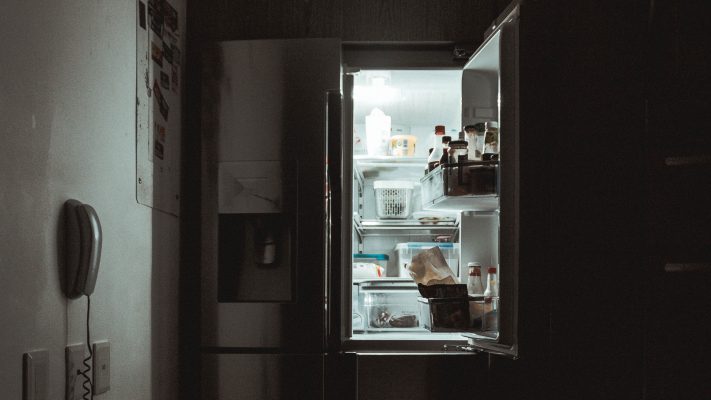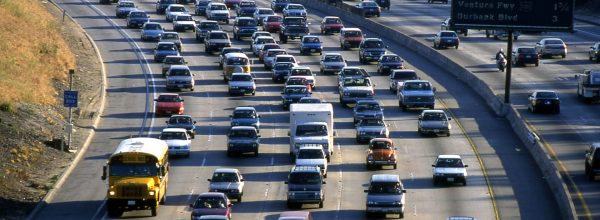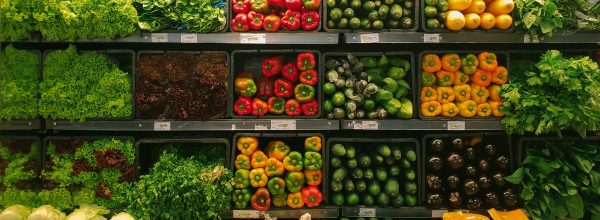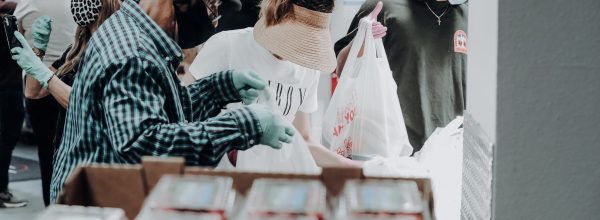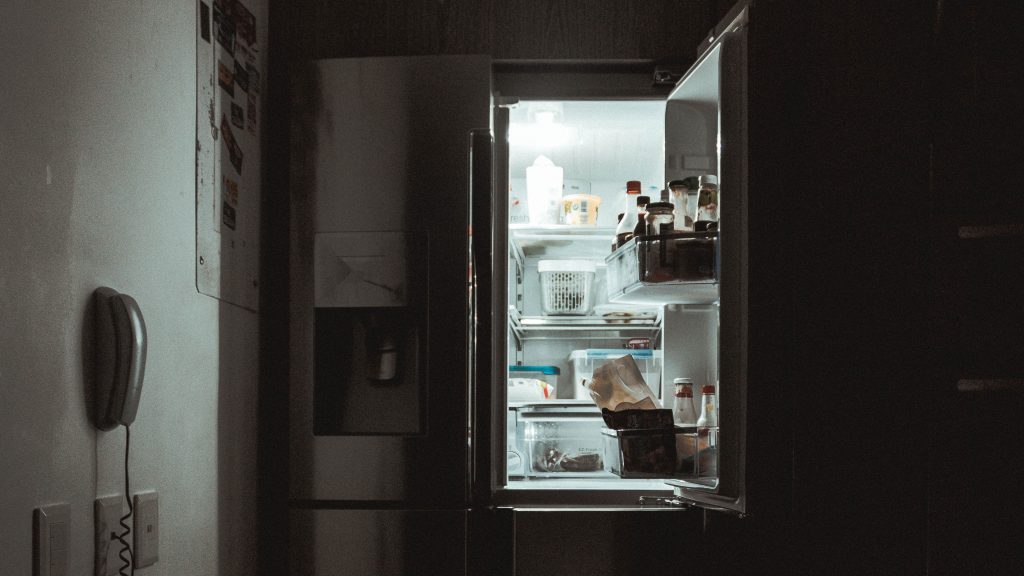
We’ve all seen the images, a stunning visual representation of the double whammy punch landed by an unprecedented public health pandemic and resulting record unemployment.
Miles-long lines of cars with thousands of people waiting to enter food banks in California, Florida, Ohio, Pennsylvania, Texas, and elsewhere in the country. Some food relief organizations, such as Second Harvest Food Bank of Orange County, responded by providing their first pop-up, drive-through food distribution for people in need. So did a similar effort in Inglewood, California in partnership with the Los Angeles Regional Food Bank.
In the midst of the COVID-19 crisis food insecurity is surging in the United States and food banks are struggling to meet the need.
More than 38 million Americans — about 1 in 7 people — were food insecure in 2018, according to U.S. Department of Agriculture data. That number could double in the wake of the economic havoc caused by the novel coronavirus, according to a spokesperson for Feeding America, a hunger relief nonprofit that oversees 200 food banks.
Demand for food aid has increased as much as eightfold in some areas, according to an investigation by The Guardian. With 16 million and counting joining the unemployed ranks across the U.S. within weeks of the COVID-19 crisis, food insecurity is a major concern for many Americans right now. That’s especially the case for employees in the retail, restaurant, and hospitality service industries, where thousands of workers — who often live paycheck to paycheck — have been laid off, with little or no buffer as yet against the abrupt loss of income.
All this demand is spiking at a time—because of stockpiling and social distancing mandates—when food is becoming more challenging to access. Many grocery stores are stripped bare and there are long waits to enter many supermarkets. Food pantries are dealing with shortages of donated food, as restaurants, hotels, and casinos — all vital sources of surplus food — are shut due to COVID-19 and grocery stores have no excess. (On top of that, volunteer workers are typically retirees, most of whom are sheltering in place, under government directives or doctors’ orders.)
Adding to the challenge: schools and childcare centers are closed across the country due to COVID-19, which means that many families who rely on free or reduced-cost school breakfasts, lunches, snacks, and even dinner to feed their children are facing greater need. The school lunch program, notes an NPR report on the problem, is the second-biggest anti-hunger initiative in the country, after the Supplemental Nutrition Assistance Program, (SNAP), formerly referred to as food stamps. In a pivot that’s had a profound impact in communities across California and elsewhere, schools have continued to find ways to feed students and their families. As one student nutrition services provider told a reporter: “The title of lunch lady is going to be replaced with school nutrition hero. Not all heroes wear capes; some wear aprons.”
How to help patients in need? Here’s a guide to public, private, and nonprofit resources during the pandemic, with a particular emphasis on California, for clinic clients who need food relief right now:
- U.S. Department of Agriculture/Food and Nutrition Services has compiled a list of updated program information in response to COVID-19, including state waivers, flexibilities, and contingencies in relation to enrollment in government food aid programs for children, seniors, and individuals with disabilities. The site includes details on programs such as Child Nutrition, WIC (Women, Infants, and Children), and SNAP. It also includes a school meals site finder. Find tips for meal planning, cooking, and shopping during social distancing at MyPlate.
- California Department of Education has posted a list of all school districts and locations offering grab-and-go meals during the COVID-19 school closure. They’ve also created an app, “CA Meals for Kids,” to help families locate food pick-up sites.
- School Lunch is still on the table. The COVID-19 Child Nutrition Response Act established a nationwide waiver to help school districts continue to provide students with meals while minimizing exposure to the novel coronavirus. Even though schools are currently online, school district nutrition staff and scores of volunteers are still feeding children, and in some cases, adults too. For instance, The Los Angeles Unified School District — with 700,000 students, the nation’s second largest — has served roughly 5 million meals to children and adults alike at 63 grab-and-go food centers set up since it closed schools March 16, according to Civil Eats. Find the LAUSD student pick up sites map here. The LAUSD Superintendent announced that his district is serving more meals daily than any of the nation’s food banks, according to the Civil Eats story. The district distributed more than 432,000 meals on one day alone. It is also providing meals to 13 temporary homeless shelters in Los Angeles. Meanwhile, New York City Public Schools, the largest district in the U.S., has 400 grab-and-go meal hubs, which is also now offering free meals to both students and adults.
- CalFresh is California’s version of SNAP, which provides federally funded benefits each month to low-income residents. Sign up online at CalFresh. In April, CalFresh recipients will receive an Emergency Allotment on their Electronic Benefit Transfer (EBT) Card, which can be used to buy food at many farmers markets, grocery stores, and supermarkets. California and Arizona were recently approved to participate in a pilot program that allows SNAP recipients to purchase groceries online (Amazon and Walmart are the current retailers accepting such payments). Other states that can offer SNAP online include Alabama, Florida, Idaho, Iowa, Nebraska, New Jersey, New York, and Washington. There has been a record upswing in the number of applications for CalFresh, according to Code for America, a nonprofit that partners with the state to sign up people for the program. According to the Los Angeles Times, the group had seen a 350 percent increase in applications since COVID-19.
- Online tools such as One Degree can help locate community food resources in a couple of clicks; the site is frequently updating information for both the San Francisco Bay Area and Los Angeles County in response to the rapidly-evolving COVID-19 crisis. Another online social care network resource, Aunt Bertha, designed the findhelp.org tool in response to the pandemic, for people needing food assistance and other aid. It includes new programs in response to COVID-19. Meanwhile, the social care coordination platform Unite Us is working with its health care partners to ensure accurate, up-to-date information in a scenario that is constantly changing. Free Food is an online user-populated resource that lists — by state and city — food pantries, soup kitchens, food shelves, and food banks around the country. It’s a useful resource for services outside large metropolitan areas. Food Pantries is a similar site.
- Los Angeles Food Policy Council put together a detailed COVID-19 resource list on programs offering free meals, free or subsidized food delivery services, as well as information on where to find farmers markets, food banks, and food pantries.
- Food Banks continue to provide free perishable and non-perishable groceries. Use the California Association of Food Banks find a food bank online service or call 211 to locate a nearby food bank or food pantry. Central California Food Bank has seen a 50 percent increase in demand, similar to other areas. The food banks are adapting to meet growing need: San Francisco-Marin Food Bank is running new pop-up food pantries. Los Angeles Regional Food Bank is distributing record breaking amounts of food during the pandemic to pantries around the area. Alameda County Food Bank has increased its distribution of emergency food bags, which include shelf-stable groceries intended to last a few days. San Diego Food Bank is offering emergency drive-thru food and essential supplies. Sacramento Food Bank is also offering “touchless” drive-thru food distribution direct to consumers.
- World Central Kitchen, the global food-relief nonprofit founded by celebrity chef José Andrés, launched “Chefs for America,” to respond to the pandemic, and has partnered with organizations on the ground to feed people in need due to the virus crisis in Oakland, Los Angeles, New York City, Washington, D.C., Little Rock, Newark, New Orleans, Puerto Rico and elsewhere in the nation.
- Community kitchens have sprouted in restaurants closed for dining across California to feed people in need, either directly or through nonprofit programs. Everytable is offering meals to all vulnerable Angelenos, including food distribution for seniors who need food brought to their homes. Luka’s Taproom & Lounge in Oakland is working under the umbrella of a nonprofit to feed the unsheltered. The nonprofit SF New Deal has partnered with a slew of Bay Area restaurants to feed the most vulnerable during the crisis.
- County and city initiatives in response to increased demand for food services include a Santa Clara County food locator map, which features more than 400 food distribution sites, including free meal pick-up locations for students and seniors, and food pantry locations. In Los Angeles, the Mayor’s Office Angeleno Campaign is providing grocery gift cards and pre-paid debit cards for individuals hard hit by the current crisis.
- Nonprofit food relief organizations are also stepping up to help meet demand. The San Diego Hunger Coalition offers links to nonprofit feeding programs in the area in response to COVID-19. During the initial lockdown, Project Angel Food in Los Angeles delivered three weeks-worth of additional frozen meals and shelf-stable pantries to its 1,600 clients with life-threatening illnesses.
- Serious Eats, an online cooking site, offers a comprehensive food safety and handling guide during COVID-19 as well as a guide to how to sanitize a home kitchen during the crisis.
Find this useful or interesting? We’re constantly sharing stuff like this. Sign up to receive our newsletter to stay in the loop.

